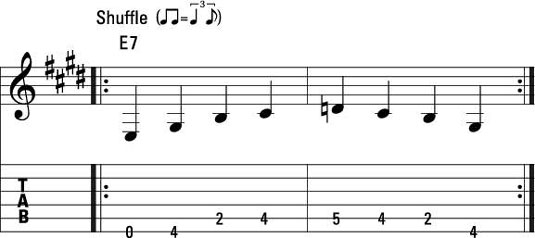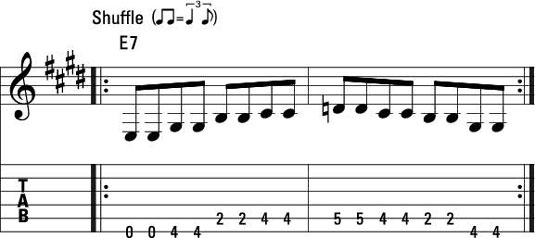A riff is a self-contained musical phrase on the guitar, and it can be used to form the basis for a song. Riffs are the bridge between chords and lead guitar. Riffs are usually based on single notes, but they can involve double-stops (two notes played simultaneously) and bits of full-chord playing.
You may hear the terms riff and lick used interchangeably in your blues guitar career. A riff is more of a structural, repeatable phrase, and a lick may well be a cliché — that is, it’s a self-contained lead figure that doesn’t necessarily have structural importance (like those short, snappy melodic phrases played by blues and country guitar-players between vocal lines).
The signature guitar parts in the Stones’ “Satisfaction” and the Beatles’ “Day Tripper” are classic examples of riffs. In blues, the crisp, ascending, horn-like melodic bursts in Freddie King’s “Hide Away” are riffs, as is the repeating pattern in Bo Diddley’s “I’m a Man.”
Here, you look at riffs in order of increasing rhythmic activity, starting with quarter notes, advancing through eighth notes (the straight, shuffle, and triplet varieties), and moving to the more complex 16-note-based and syncopated riffs (which involve eighths and sixteenths).
Just as you do when playing chords, you must play riffs with a solid and consistent approach to articulation (attack), rhythm, and dynamics (overall loud and soft) to help keep the drive in the guitar part.
Use a metronome to help keep yourself playing along with the beat, and use a combination of your ears and muscle memory to make sure you strike the strings with the same force for achieving consistent dynamics.
For the low-down bass notes: Quarter-note riffs
You may think you can’t do much to groove hard with boring ol’ quarter notes, but the quarter note drives a lot of boogie-woogie bass lines. Boogie-woogie and blues are close cousins, and you can always throw in a boogie bass as a variation to almost any medium- to uptempo shuffle. Here is a common quarter-note boogie pattern that you can play easily with just downstrokes.

The big daddy of riffs: Eighth-note riffs
Most riffs in blues are eighth-note based, so there’s a wide range of music you can play in an eighth-note groove. But to start off, jump into eighth-note riffs by taking quarter-note riffs and doubling them up — that is, play two notes per beat instead of one. Here is a boogie-bass pattern in shuffle eighth-notes.

Another popular riff is the stop-time feel. It features the low notes of the guitar. The entire band plays a figure in unison and stops at the downbeat of each measure in the phrase, like in “Blue Suede Shoes.” This approach is used famously in the Muddy Waters tunes “Mannish Boy” and “Hoochie Coochie Man.” Check out this tribute to the stop-time riff.

Here’s a riff in the style of Freddie King’s “Hide Away” — one of the most recognizable eighth-note riff-based songs in the blues repertoire.

Adding a little funk: 16th-note riffs
Funky blues usually sound that way because sixteenth notes are in the mix. In a sixteenth-note groove, the tempos tend to be moderate. But because the beats use sixteenth-note subdivisions, the groove sounds quite active. Often the bass line and drums (particularly the hi-hat) employ sixteenth notes to lend support to the scratchings laid down by the guitar.
Here is a sixteenth-note riff on the low strings that you play with strict alternate (down-up-down-up) picking.

Throwing rhythm for a loop: Syncopated eighth-note riffs
Although syncopation isn’t a huge influence in the blues (compared to, say, jazz, R&B, and funk), it’s used sometimes and is always a welcome treat.
Check out a syncopated blues line consisting of a dotted eighth, a tie, and sixteenth notes.

If you’re practicing this syncopation and it gives you trouble at first, try practicing the line without the tie (so you’re playing both notes in the tie). Then, when you’re confident with the figure, practice the tie by letting the note ring through.

